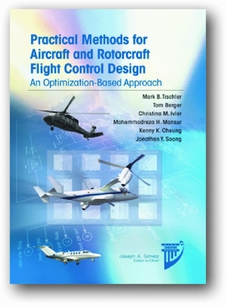
The field of aircraft control systems design is one that faces thought-provoking challenges at its core. The ultimate purpose is far beyond merely stabilising aircraft – the complicated and fickle field of handling qualities (how the handling behaviour of an aircraft is perceived by humans flying in them, particularly those piloting them) must somehow meet and cooperate with the rich and rigorously technical elements of control theory.
First and foremost, this book does well to impart on the reader a sense of this challenge. Dismantling the title and assessing the book against the constituent pieces, we are to expect both fixed-wing and rotary-wing configurations to be covered, the overall strategy of the book to be of practical use and optimisation to be the tool used in doing so. The book does deliver on each of these counts. Concepts explained are given background in both fixed and rotary wing contexts. Regarding practicality: a comprehensive guide to the implementation of these concepts is provided through recourse to the CONDUIT tool in MATLAB, and real-world case studies are supplied for examination. The benefits of using multi-objective parametric optimisation for the design of aircraft control systems is well explained, as well as decent coverage of the theory behind the available optimisation algorithms themselves.
Following the quantitative-qualitative schism through to the completion of the design process, the book is particularly insightful in its explanation that ultimately all optimised design points are compromises between the conflicting requirements and are therefore a function of how those requirements have been prioritised, which itself is a matter concerned with what exactly the control system is being designed for.
Chapters 1–3 introduce the reader to the flight control system design field as a whole, multi-objective parametric design and the CONDUIT software. Chapters 4–6 cover case studies and the rigorously qualitative aspects of control system design, in terms of the requirements that are to be satisfied through the optimisation. Chapters 7–9 cover the actual design of control systems, including sensitivity and robustness assessment of the design point selected by the optimisation. Chapters 10–13 cover more advanced concepts beyond the completion of the optimisation, such as flight-test evaluation of control laws and alternative design methods.
The reader may be left wanting for more thorough exploration of the helicopter case study, which rather lies in the shadow of the XV-15 tiltrotor one that is given, or perhaps a more even balance of fixed-rotary wing case studies. Additionally, the large number of authors contributing to the book has lent it a slightly piecewise feel; for instance, the same XV-15 top level block diagram appears several times throughout the work, introduced each time as if it were the first. These are, however, minor blemishes, and on the whole, the work is well-considered, polished and suitable for both students and engineers in industry.


